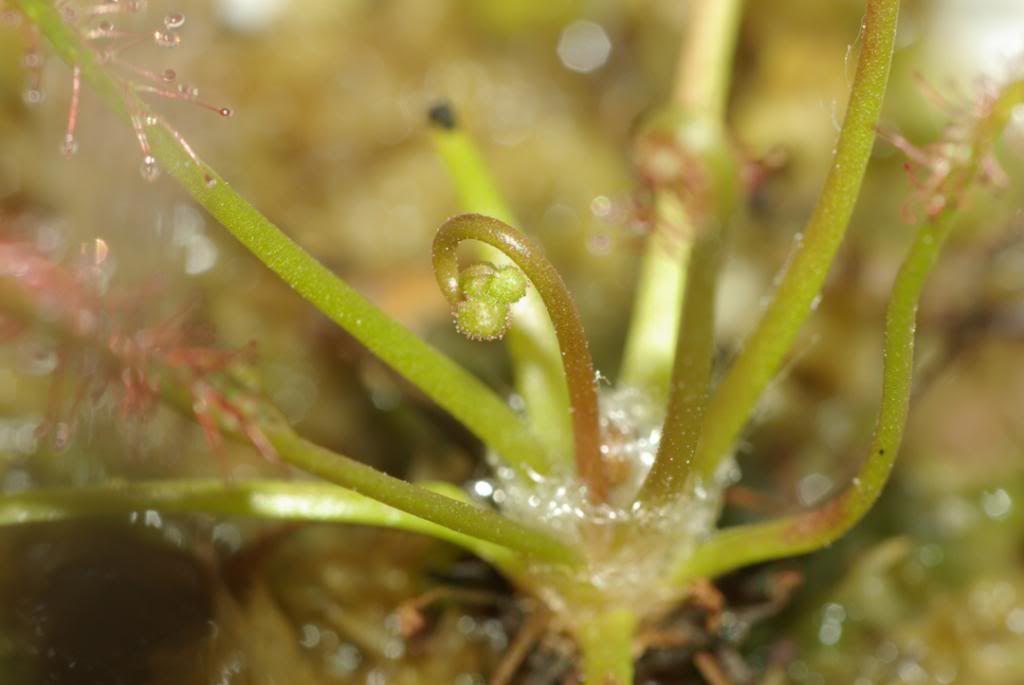|
|
Post by John Brittnacher on Jul 26, 2012 19:06:56 GMT
The Drosera x hybrida tetraploids are now blooming. This is the natural tetraploid from seed collected at the Butterfly Valley Botanical Area in California. The tetraploids so far have had shorter leaves and scapes than the non-tetraploid plants. However the plants look "muscular" with wider growing apex and petioles. The flowers are 18 mm wide while the non-tetraploid flowers are 14 mm wide. Both flowers below have malformed styles.    For comparison here are images of the non-tetraploids from Butterfly Valley. I don't know if the color difference of the plants is significant as there are slight differences in the soil between the plants.   |
|
|
|
Post by joegriffin on Aug 2, 2012 23:02:49 GMT
Pretty dew!
|
|
|
|
Post by John Brittnacher on Aug 3, 2012 19:14:52 GMT
The flowers are only fully open for about an hour... This one was already starting to close but you can see the styles in more detail. All of the flowers on this plant had malformed stigmas. This was the most "normal". Also see the humugus stamen I had to shoot the photo around.  Notice how the stigma looks like it wants to be 4-part instead of 3 part (i.e. to be divide like an "x" at the top of the ovary instead of a "y"). There was one flower I did not get a photo of that actually had little nubs where a fourth part would be. |
|
|
|
Post by Not a Number on May 17, 2013 21:13:46 GMT
Did these produce seed for you? The one plant I have from a seedling I obtained from Harry Tryon is starting to flower this year. I put it in the refrigerator for dormancy this last winter.  |
|
|
|
Post by John Brittnacher on May 20, 2013 3:01:25 GMT
Not only do I have dozens of small plants from the seeds collected last fall from the plants I got from Harry but I also have seedlings from a plant collected at Butterfly Valley. Well, at least I believe the plant that produced seeds was derived from one of the wild collected ones. None ever produced seeds before but I can't imagine how a mature plant from Harry could have ended up in the pot with half a dozen other mature non-seed producing plants with a tag saying they were from the plants collected in 2007 during the eradication. The plant in question is now in its own pot and doesn't look like the purported tetraploids.
I may also have some newly derived D. x hybrida. And I hope D. intermedia x (filiformis x tracyi).
|
|
|
|
Post by Not a Number on Jun 2, 2013 7:13:43 GMT
Interesting that you should get alloploidy with this hybrid in your backyard. As you mentioned before it happens all the time. I hope I will be able to photograph the flowers and get seed from this plant. Maybe it is not as picky about the climate as the tetraploid D.× beleziana.
|
|
|
|
Post by Not a Number on Jun 10, 2013 20:56:03 GMT
Well this is the best I could do. Only one more bud unless a few more develop. Not likely. Stigma are also malformed. Petals are pale pink.  |
|
|
|
Post by Not a Number on Jul 24, 2013 19:12:18 GMT
There were only two flowers and I was unable to photograph either any wider open. Very little seed if any was produced. A mealybug infestation may have had something to do with it. I'll give the seed to Ivan Snyder to germinate and observe.
The plant has since formed a winter bud. I'm at odds as whether to put it into the refrigerator or not.
|
|
|
|
Post by John Brittnacher on Jul 28, 2013 1:46:12 GMT
My Drosera x hybrida are just now flowering and tend to do their best growth August. They had a rough spring. I got very few flowers on the tetraploids. What I was hoping to be one year of experiments before the "Drosera x hybrida, the next generation" followup paper is now stretching to three or five years.
|
|







